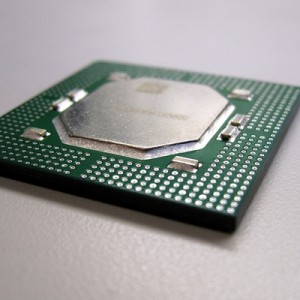基于ARM处理器技术的芯片将被连接在一起,模拟大脑的高度复杂的运作,其工作方式就像相互作用、高度连接的数十亿神经元的网络。
这项工作严重依赖的芯片已通过出色的功能测试,并于上月发布。将用它们组成一个所谓的大三角帆大型计算机(扣球神经网络结构),其目的是映射出大脑的各个功能。
三角帆大型计算机可以成为神经学家,心理学家和医生的一个重要工具,帮助他们了解复杂的脑损伤,疾病和病症,并找出最有效的疗法。
曼彻斯特大学被将为该项目设计系统体系结构,并收到EPSRC 500万英镑赠款的一半作为研究经费,英国南安普敦大学、剑桥、谢菲尔德将分别承担项目的其余工作。
虽然三角帆巨型计算机有一百万个ARM处理器 – 现在大多数手机都在使用的技术,计算机科学家指出,大三角帆计算机最终也只能重新塑型人类大脑的1%。但教授史蒂夫•弗伯领导的研究人员们,相信大三角帆计算机将成为神经学家和心理学家用来测试个人大脑特性推理的一个重要工具。
此项目的关键挑战是开发和理解大脑的信息处理和极高度的脑细胞连接。人类大脑中有100亿个神经元及10亿个连接组成。在这个系统中,神经元发出尖峰电压随后以微小的电信号传递。
每个电脉冲在三角帆计算机中作为一个数据“包”,这种数据处理方式就像互联网中进行信息传递方式的一个缩减版本。这个包随后被发送到所有连接的神经元。神经元用小型简单的公式表示,用运行在实时ARM处理器上的软件来模拟。
三角帆计算机中的电子连接传达这些尖峰比大脑中的生物连接更快,因为三角帆可以使用更少的连接传输尖峰,因而更有效和更迅速。
测试芯片在2009年就被开发出来。但现在交付的完整芯片是在曼彻斯特设计、在台湾生产的,可以使科学家开发出更大的系统,它可以用来模拟大脑。每个芯片中包含18个ARM处理器。
友尼森欧洲有限公司在威尔士南部有包装设施,它使用3D系统级封装技术把定制的微芯片与提供内存的第二个芯片一起封装在在一个19毫米正方形封装内。这个狭小的封装提供了一台PC的计算能力,消耗大约一瓦的电力。
来自计算机科学学院的弗伯教授说:“我们希望这个机器将来能够模拟人类大脑的重要职能,并帮助我们了解到大脑运作规则。
“开发和理解大脑中的信息处理是其中的关键。在大学和其他地方,我们正在积极与神经学家和心理学家合作。
“这可能对一些患者有很大的帮助,例如,那些因为中风或类似的脑损伤造成的阅读问题。心理学家已经开发出了神经网络,在那上面他们可以重现临床病理。
“他们使用这些网络测试替代疗法,以确定最有效地治疗病人的症状的方法。目前他们被现有计算机能力所限,但我们希望三角帆巨型计算机能提供更高的能力。
“我们不知道大脑作为一个信息处理系统工程是如何工作的,但是我们需要找出来。我们希望我们的机器在这方面取得重大进展。
“ARM在2005年5月开始参与三角帆项目。随后的知识产权协议为使用ARM处理器铺平了道路。与使用ARM单元库一起,这项协议还涉及设计和制造。该协议允许英国曼彻斯特大学为三角帆系统以及一些更小的测试系统制造1万个基于ARM处理器的芯片。”
迈克•穆勒,ARM首席技术官评论说:“ARM体系结构使ARM的合作伙伴能生产出更出色的系统,优化系统性能和降低功耗,三角帆旨在为最终的智能系统人类的大脑建模。史蒂夫是ARM家族的一部分,这个项目与他和英国曼彻斯特大学的合作是一个完美的方式,而且这个项目也使ARM在英国的研究处于领先地位。”

生物探索推荐英文原文:
Chips Hold the Key to Understanding the Human Brain
The chips upon which this work critically depends were delivered last month, and have passed their functionality tests with flying colours.
They will form the system architecture for a massive computer, called SpiNNaker (Spiking Neural Network architecture), which aims to map out the brain's individual functions.
SpiNNaker could be a vital tool for neuroscientists, psychologists and doctors to help them understand complex brain injuries, diseases and conditions, and identify the most effective therapies.
The University of Manchester was selected to design the system architecture for the project, and received half of the £5m EPSRC grant which supported the work, while the universities of Southampton, Cambridge and Sheffield share the rest to work on other parts of the project.
Even though there will be up to one million ARM processors, -- technology used in most of the world's mobile phones- in the final SpiNNaker machine, computer scientists point out that this will enable them to recreate models of only up to 1% of the human brain.
The researchers, lead by Professor Steve Furber, believe the machine will be a vital tool for neuroscientists and psychologists to test hypotheses on individual brain characteristics.
The key challenge is developing and understanding the information processing of the brain and the extremely high connectivity of the brain cells. There are 100 billion neurons with 1,000 million connections in the human brain. In this system, the neurons emit spikes which are relayed as tiny electrical signals. Each impulse is modelled in SpiNNaker as a 'packet' of data, a very-much scaled down version of the way the internet carries information.
This packet is then sent to all connected neurons. Neurons are represented by small simple equations which are solved in real-time by software running on the ARM processors.
The electronic connections in SpiNNaker convey these spikes much quicker than the biological connections in the brain, hence SpiNNaker can transmit spikes as effectively and quickly with many fewer connections.
Test chips were brought out in 2009, but now the full chips, designed in Manchester and manufactured in Taiwan, have been delivered and will allow the scientists to develop much larger systems which can model the brain. Each chip contains 18 ARM processors.
The bespoke microchips are integrated in a single 19mm square package with a second microchip that provides substantial memory using 3D System-in-Package technology from Unisem Europe Ltd, who have packaging facilities in south Wales. This package delivers the computing power of a PC in a tiny space and for around one watt of electrical power.
Professor Furber, from the School of Computer Science, said: "We hope the machine will be able to model important functions of the human brain and help us gain key insights into their principles of operation.
"Developing and understanding the information processing in the brain is the key. We are actively engaging with neuroscientists and psychologists, both here at the University and elsewhere.
"This could ultimately be of great help for patients, for example, who have presented with reading problems caused by strokes or similar brain injuries. Psychologists have already developed neural networks on which they can reproduce the clinical pathologies.
"They then use these networks to test alternative therapies, to identify which is most effective in treating the patient's symptoms. At present they are limited in the fidelity they can achieve with these networks by the available computer power, but we hope that SpiNNaker will raise that bar a lot higher.
"We don't know how the brain works as an information-processing system, and we do need to find out. We hope that our machine will enable significant progress towards achieving this understanding."
"The ARM architecture is all about enabling the ARM partner ecosystem to produce smarter systems that are optimized for performance and power consumption," commented Mike Muller, Chief Technical Officer, ARM."SpiNNaker seeks to create a working model of the ultimate smart system, the human brain. Steve is part of the ARM family, so this project was a perfect way to partner with him and Manchester University, and for ARM to encourage leading research in the UK."







